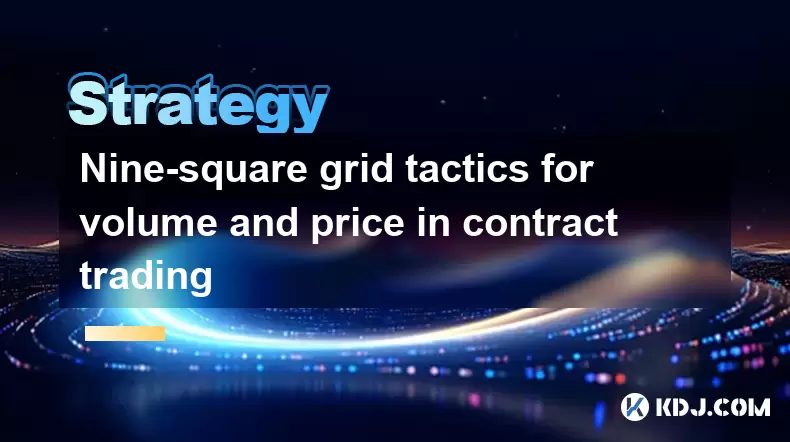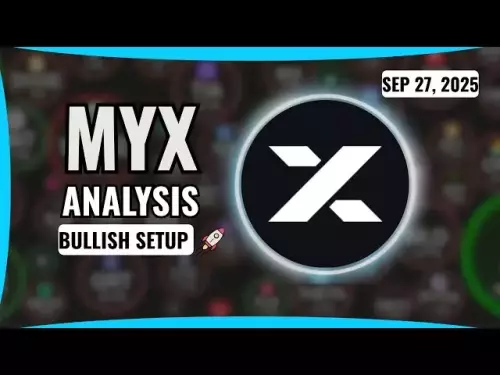-
 bitcoin
bitcoin $109523.663807 USD
-0.13% -
 ethereum
ethereum $4019.526508 USD
2.06% -
 tether
tether $1.000482 USD
0.00% -
 xrp
xrp $2.776815 USD
0.18% -
 bnb
bnb $958.942396 USD
0.12% -
 solana
solana $204.294698 USD
3.84% -
 usd-coin
usd-coin $0.999693 USD
0.00% -
 dogecoin
dogecoin $0.232115 USD
2.09% -
 tron
tron $0.338028 USD
0.84% -
 cardano
cardano $0.790920 USD
1.50% -
 hyperliquid
hyperliquid $44.871443 USD
5.60% -
 ethena-usde
ethena-usde $1.000322 USD
0.04% -
 chainlink
chainlink $21.034165 USD
2.60% -
 avalanche
avalanche $28.794831 USD
-0.54% -
 stellar
stellar $0.360466 USD
1.24%
Nine-square grid tactics for volume and price in contract trading
Traders use the nine-square grid to analyze volume and price, making informed decisions on buying or selling crypto contracts based on market trends.
Jun 04, 2025 at 02:21 pm

In the world of contract trading within the cryptocurrency market, traders often seek sophisticated strategies to maximize their profits and manage risks effectively. One such strategy that has gained popularity is the nine-square grid tactics for volume and price. This method involves dividing a trading chart into a nine-square grid, each square representing different combinations of volume and price levels. By understanding and applying this grid effectively, traders can make more informed decisions about when to buy or sell their contracts.
Understanding the Nine-Square Grid
The nine-square grid is a visual tool that helps traders analyze market trends and potential trading opportunities. The grid is divided into three horizontal rows and three vertical columns, creating nine individual squares. Each square represents a unique combination of volume and price, allowing traders to see at a glance where the market is in terms of these two critical factors.
Volume is represented on the vertical axis, with high volume at the top and low volume at the bottom. Price is represented on the horizontal axis, with high prices on the right and low prices on the left. By plotting current market conditions onto this grid, traders can quickly identify whether the market is experiencing high volume at high prices, low volume at low prices, or any other combination.
Setting Up the Nine-Square Grid
To effectively use the nine-square grid, traders must first set up their trading charts correctly. Here's how to do it:
- Choose a suitable trading platform: Ensure that the platform you use supports the necessary charting tools and indicators.
- Select the right timeframe: Depending on your trading strategy, choose a timeframe that aligns with your goals, whether it's short-term or long-term trading.
- Create the grid: Use the platform's drawing tools to divide the chart into nine equal squares. Ensure that the vertical axis represents volume and the horizontal axis represents price.
- Adjust the grid: Fine-tune the grid to match the specific market conditions you are analyzing. This might involve adjusting the scale of the volume and price axes to better reflect current market dynamics.
Interpreting the Nine-Square Grid
Once the grid is set up, the next step is to interpret the data it presents. Each square on the grid offers different insights into market conditions:
- Top-right square (High Volume, High Price): This square indicates a strong bullish market where high trading volume accompanies rising prices. It's often a good time to consider buying contracts.
- Top-left square (High Volume, Low Price): This scenario suggests a potential reversal. High volume at low prices can indicate that the market is bottoming out and may soon rise.
- Bottom-right square (Low Volume, High Price): This situation can be a warning sign of a potential bearish reversal. Low volume at high prices may indicate that the market is overbought and due for a correction.
- Bottom-left square (Low Volume, Low Price): This square often signals a bearish market where low volume accompanies falling prices. It might be a good time to consider selling contracts or staying out of the market.
Applying the Nine-Square Grid in Trading
Applying the nine-square grid in real-time trading involves monitoring the grid and making decisions based on the current position of the market within it. Here are some strategies to consider:
- Trend Following: If the market consistently moves from the bottom-left to the top-right of the grid, it indicates a strong bullish trend. Traders can take advantage of this by buying contracts and holding them until the market reaches the top-right square.
- Reversal Trading: When the market moves from the top-right to the bottom-left, it may signal a bearish reversal. Traders can sell their contracts or short-sell to profit from the expected downturn.
- Breakout Trading: If the market breaks out of the grid, either by exceeding the top volume or the right price, it can signal a significant move. Traders can position themselves to take advantage of these breakouts by buying or selling accordingly.
Risk Management with the Nine-Square Grid
Effective risk management is crucial when using the nine-square grid tactics. Here are some tips to manage risks:
- Set Stop-Loss Orders: Always set stop-loss orders to limit potential losses. Place these orders just outside the grid boundaries to protect against unexpected market movements.
- Diversify Your Portfolio: Don't put all your capital into one trade. Spread your investments across different contracts to minimize risk.
- Monitor Market Conditions: Keep an eye on broader market trends and news that could affect the cryptocurrency market. Adjust your grid and trading strategy accordingly.
Practical Example of Using the Nine-Square Grid
To illustrate how the nine-square grid can be used in practice, let's consider a hypothetical scenario involving Bitcoin futures contracts:
- Initial Setup: You set up your trading chart with a nine-square grid, focusing on a daily timeframe. The current market shows Bitcoin trading at $30,000 with moderate volume.
- Market Movement: Over the next few days, the price of Bitcoin rises to $35,000, and the trading volume increases significantly. On the grid, the market moves from the middle square to the top-right square.
- Trading Decision: Seeing the market in the top-right square, you decide to buy Bitcoin futures contracts, anticipating further price increases.
- Monitoring and Adjustment: You continue to monitor the grid. If the market moves back towards the middle or bottom squares, you might consider selling your contracts to lock in profits.
Frequently Asked Questions
Q: Can the nine-square grid be used for all types of cryptocurrency contracts?A: Yes, the nine-square grid can be applied to various types of cryptocurrency contracts, including futures, options, and perpetual swaps. However, the effectiveness of the grid may vary depending on the specific market dynamics and the liquidity of the contract.
Q: How often should the nine-square grid be adjusted?A: The frequency of adjusting the grid depends on the trader's strategy and the volatility of the market. For highly volatile markets, daily adjustments might be necessary, while for more stable markets, weekly adjustments could suffice.
Q: Is the nine-square grid suitable for beginners?A: While the nine-square grid can be a powerful tool, it may be challenging for beginners due to its complexity. New traders should start with simpler strategies and gradually incorporate the nine-square grid as they gain more experience.
Q: Can the nine-square grid be used in conjunction with other technical indicators?A: Yes, the nine-square grid can be effectively combined with other technical indicators such as moving averages, RSI, and MACD to enhance trading decisions. Using multiple indicators can provide a more comprehensive view of market conditions.
Disclaimer:info@kdj.com
The information provided is not trading advice. kdj.com does not assume any responsibility for any investments made based on the information provided in this article. Cryptocurrencies are highly volatile and it is highly recommended that you invest with caution after thorough research!
If you believe that the content used on this website infringes your copyright, please contact us immediately (info@kdj.com) and we will delete it promptly.
- Crypto Presales: Is $BFX the Next Big Thing?
- 2025-09-28 00:25:12
- Kraken's IPO Ambitions: Navigating Valuation in a Recovering Crypto Market
- 2025-09-28 00:25:12
- Bitcoin's Bumpy Ride: Navigating Risks and Potential Downturns
- 2025-09-28 00:30:01
- Sleep Token's Macabre Metal Mastery: A Deep Dive
- 2025-09-28 00:30:01
- AI-Driven Metaverse: Building Blockchain Trust in the Digital Frontier
- 2025-09-28 00:30:01
- Lyno AI: The Altcoin Presale Primed for a 1400% Surge?
- 2025-09-28 00:30:12
Related knowledge

Practical parameter settings for a Bitcoin multi-timeframe moving average system
Sep 18,2025 at 10:54pm
Optimizing Timeframe Combinations for Bitcoin Trading1. Selecting appropriate timeframes is crucial when building a multi-timeframe moving average sys...

How can I filter out false breakouts in Dogecoin high-frequency trading?
Sep 22,2025 at 01:00am
Understanding False Breakouts in Dogecoin Trading1. A false breakout occurs when Dogecoin's price appears to move beyond a defined support or resistan...

Techniques for identifying tops and bottoms in the Bitcoin on-chain NVT model
Sep 20,2025 at 07:54pm
Understanding the NVT Model in Bitcoin Analysis1. The Network Value to Transactions (NVT) ratio is often described as the 'P/E ratio' of the cryptocur...

What does the surge in open interest in Bitcoincoin futures mean?
Sep 20,2025 at 11:18pm
Understanding the Surge in Dogecoin Futures Open Interest1. A surge in open interest within Dogecoin futures indicates a growing number of active cont...

How can I use the Ethereum USDT premium to gauge market sentiment?
Sep 18,2025 at 11:55pm
Understanding the Ethereum USDT Premium1. The Ethereum USDT premium refers to the price difference between USDT (Tether) traded on Ethereum-based plat...

What should I do if Ethereum staking yields decline?
Sep 20,2025 at 06:18am
Understanding the Causes Behind Declining Ethereum Staking Yields1. The Ethereum network transitioned to a proof-of-stake consensus mechanism with the...

Practical parameter settings for a Bitcoin multi-timeframe moving average system
Sep 18,2025 at 10:54pm
Optimizing Timeframe Combinations for Bitcoin Trading1. Selecting appropriate timeframes is crucial when building a multi-timeframe moving average sys...

How can I filter out false breakouts in Dogecoin high-frequency trading?
Sep 22,2025 at 01:00am
Understanding False Breakouts in Dogecoin Trading1. A false breakout occurs when Dogecoin's price appears to move beyond a defined support or resistan...

Techniques for identifying tops and bottoms in the Bitcoin on-chain NVT model
Sep 20,2025 at 07:54pm
Understanding the NVT Model in Bitcoin Analysis1. The Network Value to Transactions (NVT) ratio is often described as the 'P/E ratio' of the cryptocur...

What does the surge in open interest in Bitcoincoin futures mean?
Sep 20,2025 at 11:18pm
Understanding the Surge in Dogecoin Futures Open Interest1. A surge in open interest within Dogecoin futures indicates a growing number of active cont...

How can I use the Ethereum USDT premium to gauge market sentiment?
Sep 18,2025 at 11:55pm
Understanding the Ethereum USDT Premium1. The Ethereum USDT premium refers to the price difference between USDT (Tether) traded on Ethereum-based plat...

What should I do if Ethereum staking yields decline?
Sep 20,2025 at 06:18am
Understanding the Causes Behind Declining Ethereum Staking Yields1. The Ethereum network transitioned to a proof-of-stake consensus mechanism with the...
See all articles









































































